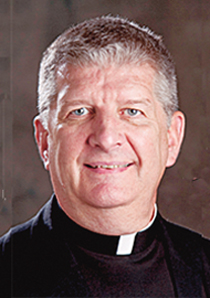
Faith
Holy days are important, they celebrate some important aspect of our Catholic faith. As Catholics, we try to do this together and the best way we do this together is by our participation at Holy Mass.

O'Grady
The article about the Immaculate Conception generated several comments and questions beyond that specific holy day to holy days in general.
Sunday is the primary holy day for all Roman Catholics. The church gathers on Sunday to celebrate the "paschal mystery" -- that is, the whole mystery and history of God's creation, our redemption in Christ, and living his life in his church until he returns in glory. There are an additional 10 days called holy days. These days are fixed by a date or by a computation of a date. For the most part, everything on the calendar ultimately relates to Easter and is dated from that "Sunday of Sundays."
The 10 holy days for the universal church (which may or may not be "of precept" or "of obligation," and which might also be transferred in some way by a conference of bishops for its territory) are:
Mary, the Most Holy Mother of God (Jan. 1)
Epiphany of the Lord (Jan. 6)
Annunciation of the Lord (March 25)
Ascension of the Lord (40 days after Easter)
Most Holy Body and Blood of Christ (60 days after Easter)
Sts. Peter and Paul (June 29)
Assumption of the Blessed Virgin Mary (August 15)
All Saints (Nov. 1)
Immaculate Conception of the Blessed Virgin Mary (Dec. 8)
Nativity of Our Lord (Dec. 25)
Each bishops' conference can choose which holy days are observed in its territory, which ones are of obligation, and which are transferred to a nearby Sunday. Dec. 25 is to be universally observed as a holy day of obligation and each conference is asked to choose one of the three Marian Solemnities for its calendar.
A conference may also add a solemnity of obligation to its calendar. Not surprisingly, March 17 is such a case in Ireland.
Some quick observations about the list.
Of the 10, five are celebrations of mysteries of the Lord; three are for those of the Blessed Virgin (Jan. 1, Aug. 15; Dec. 8) and two for saints (June 29, Nov. 1).
Of the 10, six are days of obligation (depending . . .) in the U.S. They are indicated in bold in the list above. Four of the six are observed in the 61-day period between Nov. 1 and Jan. 1 each year. There was a time in our history when there were many more days of obligation both universally and on particular or local calendars.
As of this writing, I can safely say that, of the six, Dec. 25 is always a day of obligation in the U.S. There is the conundrum of anticipated Masses, sometimes erroneously called vigil Masses, which allow an obligation and observance to be made after 4 p.m. the evening before. The multiplication of such anticipated Masses for Christmas seems to indicate that Christmas is now more observed on Dec. 24 than Dec. 25.
Likewise, the transfer in the U.S. of Epiphany to the Sunday between Jan. 2 and Jan. 8 means that we lose the celebration of the Second Sunday of Christmas and its readings and prayers; that day, Jan. 6, which is so important to many of our newly arrived sisters and brothers from other nations and cultures which observe it as their "Christmas," causes confusion in multi-ethnic communities; and the observance of the 12 days of Christmas is eliminated. Some have suggested that it might be a good idea to eliminate Jan. 1 as a holy day of obligation and replace it with Jan. 6.
In addition to the transfer of Epiphany to a Sunday, the Solemnity of Corpus Christi 60 days after Easter is transferred in the U.S. to a Sunday. Yet, neither the Solemnity of the Annunciation (March 25) nor that of Peter and Paul (June 29) is transferred.
The solemnity of the Ascension, 40 days after Easter, remains a day of obligation in some parts of the U.S., specifically in the ecclesiastical provinces of Boston, Hartford, New York, Omaha, Philadelphia of the Latins (encompassing all the New England states, New York State, Pennsylvania, and Nebraska), but not in the rest of the nation, where it is transferred to the Seventh Sunday of Easter.
Now, some advice if you want to minimize your confusion about all this, and you want to remain in the U.S. while doing so: Move to Hawaii -- there are only two holy days in the Aloha State, Dec. 8 and Dec. 25.
Holy days are important, they celebrate some important aspect of our Catholic faith. As Catholics, we try to do this together and the best way we do this together is by our participation at Holy Mass.
Despite the sometimes competing and confusing and colliding days on our calendar, these days are worth making the effort to be at Mass with one another and celebrating these mysteries of our faith.
FATHER ROBERT M. O'GRADY IS THE SPECIAL ASSISTANT TO THE PRESIDENT OF PILOT CATHOLIC MEDIA. YOU CAN REACH HIM AT RMOGRADY@PILOTCATHOLICNEWS.COM OR 617-779-3790.
Recent articles in the Faith & Family section
-
'The Chosen' Season Five sets the table for Holy WeekSister Nancy Usselmann
-
The Great VigilFather Robert M. O'Grady
-
ResilientArchbishop Richard G. Henning
-
Learning from the Missions: Commitment to God's Plan Must be TotalMaureen Crowley Heil
-
Something newScott Hahn























